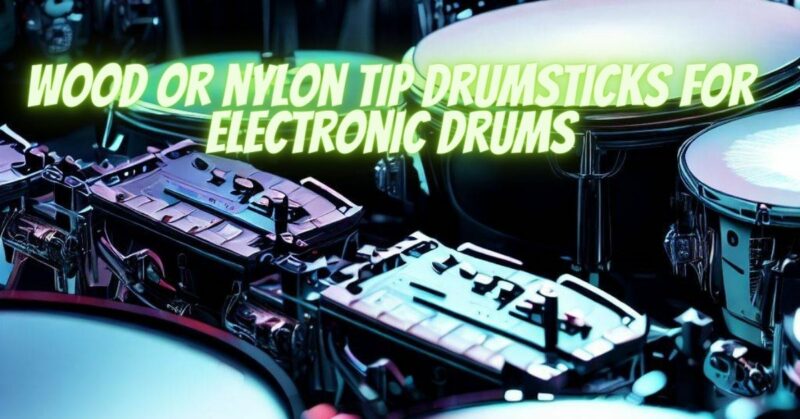Choosing between wood and nylon tip drumsticks for electronic drums is a common dilemma for drummers. Both options have their advantages and considerations when it comes to sound, durability, and playability on electronic drum pads. In this article, we will explore the characteristics of wood and nylon tip drumsticks and help you make an informed decision based on your preferences and the specific requirements of electronic drumming.
Wood Tip Drumsticks: Wood tip drumsticks are the traditional choice for drummers and offer a distinct sound and feel. Here are some key considerations:
- Sound and Tone: Wood tips produce a warmer, more organic sound compared to nylon tips. They can provide a more natural, balanced tone when playing electronic drum pads, resembling the sound of playing acoustic drums. This can be desirable if you want to replicate an acoustic drumming experience on your electronic kit.
- Response and Articulation: Wood tips generally offer a softer attack and more nuanced response on drum pads. They provide a certain level of sensitivity, allowing for subtle dynamic variations and fine control over the sound. This can be advantageous for expressive playing and intricate patterns.
- Durability: Wood tips are susceptible to wear and tear, especially when playing on electronic drum pads. Repeated striking on hard surfaces may cause the tips to chip or break more easily compared to nylon tips. However, with proper technique and care, wood tip drumsticks can still last a reasonable amount of time.
Nylon Tip Drumsticks: Nylon tip drumsticks have gained popularity in recent years, particularly for electronic drumming. Here are some important considerations:
- Durability: Nylon tips are highly durable and resistant to chipping or breaking, making them ideal for prolonged use on electronic drum pads. They can withstand the repetitive strikes without significant wear, offering longevity and cost-effectiveness.
- Consistency: Nylon tips provide consistent sound and response on electronic drum pads, ensuring a uniform playing experience. They offer a reliable attack and produce a bright, focused sound that cuts through the mix. This consistency can be beneficial for recording or live performances.
- Projection and Definition: Nylon tips tend to deliver enhanced projection and definition, making each drum hit more pronounced. This can be advantageous for genres that require strong articulation and clarity, such as electronic music or styles where precise note definition is essential.
Choosing the Right Option: The choice between wood and nylon tip drumsticks ultimately depends on personal preference and the desired sound and feel you want to achieve on your electronic drum kit. Consider the following factors:
- Sound Preference: If you prefer a warmer, more natural tone resembling acoustic drums, wood tip drumsticks may be the better choice. If you desire a brighter, more defined sound with increased projection, nylon tip drumsticks may be more suitable.
- Playing Style: Consider your playing style and the musical genres you primarily play. If you require precise articulation, strong projection, and durability, nylon tip drumsticks may be a better fit. If you value subtle dynamics, nuanced response, and a more traditional drumming experience, wood tip drumsticks may be preferred.
- Experimentation: Ultimately, don’t hesitate to experiment and try both wood and nylon tip drumsticks to determine which feel and sound resonate with you the most. Each drummer has unique preferences, so trust your ears and hands to guide you toward the right choice.
Conclusion:
Choosing between wood and nylon tip drumsticks for electronic drums involves considering factors such as sound preference, playing style, and desired durability. Wood tip drumsticks offer a warmer, more natural tone and nuanced response, while nylon tip drumsticks provide enhanced projection, consistency, and durability. Experimentation and personal preference play a significant role in making the right choice. Consider trying both types to discover which option feels and sounds best for your electronic drumming needs.


